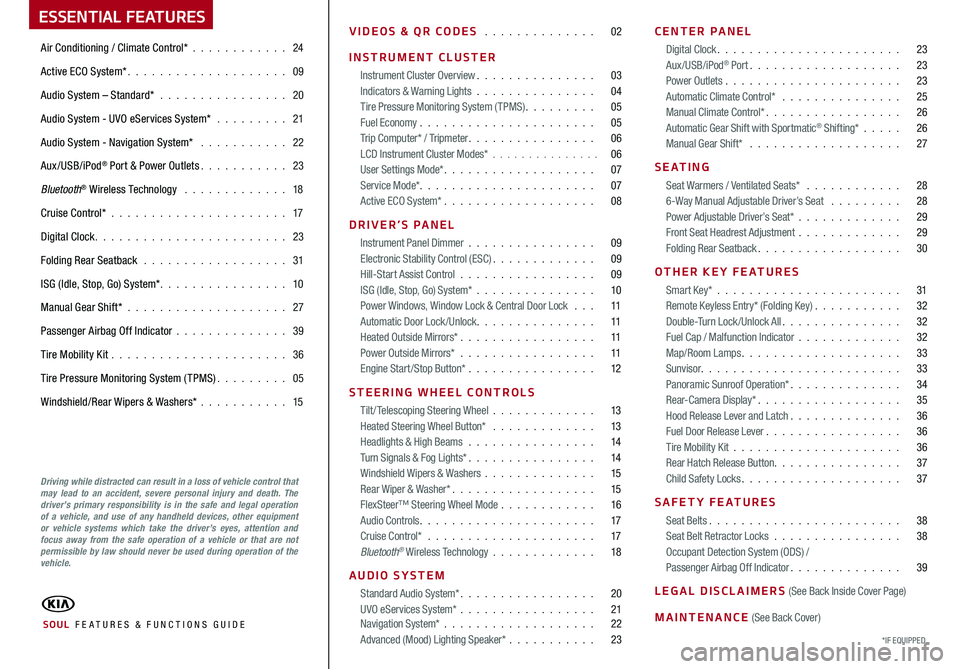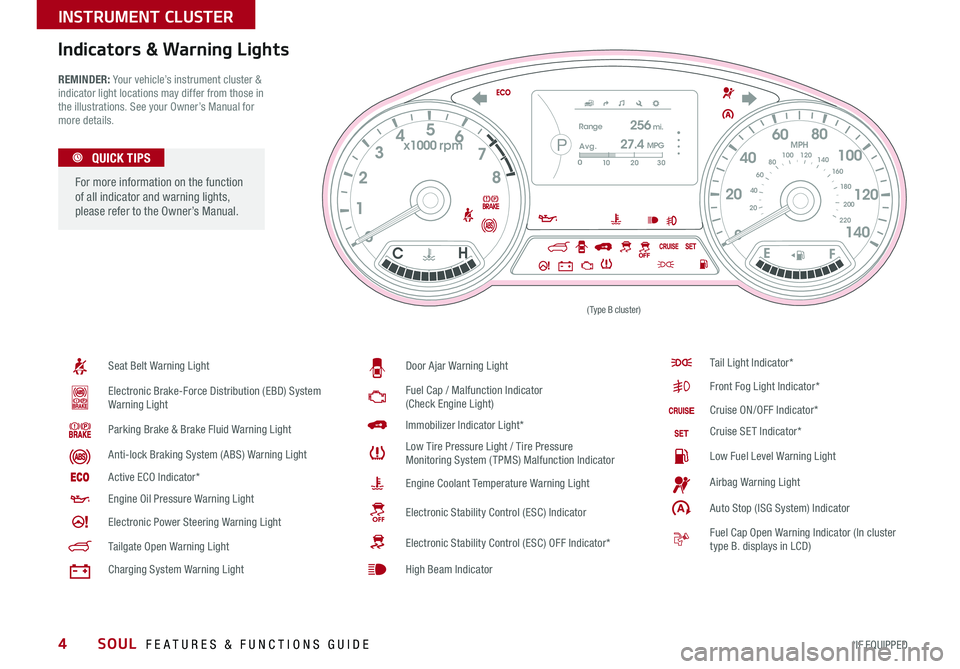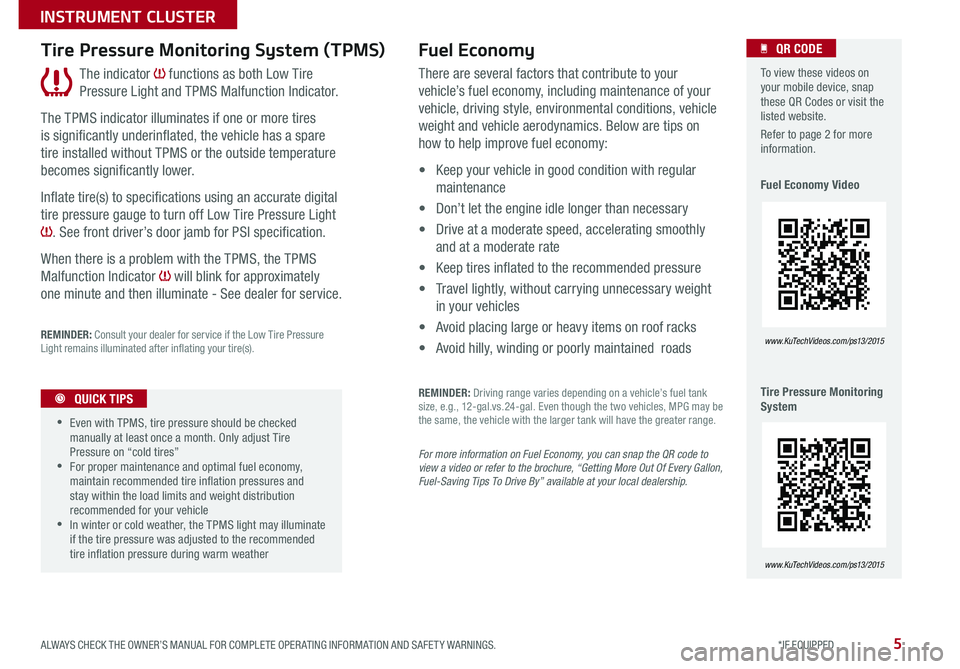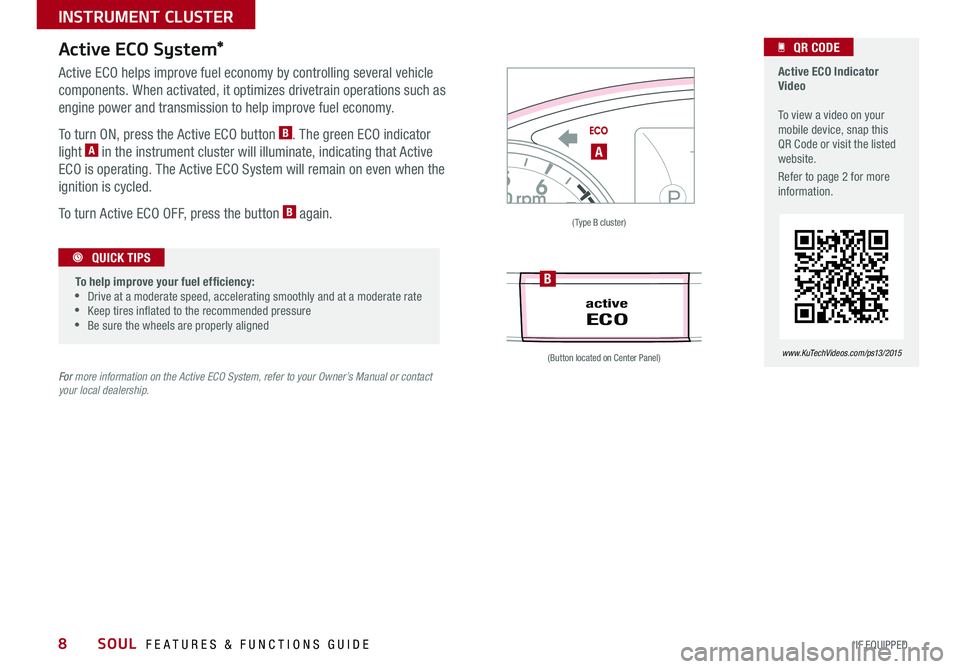fuel pressure KIA SOUL 2015 Features and Functions Guide
[x] Cancel search | Manufacturer: KIA, Model Year: 2015, Model line: SOUL, Model: KIA SOUL 2015Pages: 46, PDF Size: 5.49 MB
Page 3 of 46

ESSENTIAL FEATURES
Air Conditioning / Climate Control* 24
Active ECO System* 09
Audio System – Standard* 20
Audio System - UVO eServices System* 21
Audio System - Navigation System* 22
Aux/USB/iPod® Port & Power Outlets 23
Bluetooth® Wireless Technology 18
Cruise Control* 17
Digital Clock 23
Folding Rear Seatback 31
ISG (Idle, Stop, Go) System* 10
Manual Gear Shift* 27
Passenger Airbag Off Indicator 39
Tire Mobility Kit 36
Tire Pressure Monitoring System (TPMS) 05
Windshield/Rear Wipers & Washers* 15
VIDEOS & QR CODES 02
INSTRUMENT CLUSTER
Instrument Cluster Overview 03Indicators & Warning Lights 04Tire Pressure Monitoring System (TPMS) 05Fuel Economy 05Trip Computer* / Tripmeter 06LCD Instrument Cluster Modes* 06User Settings Mode* 07Service Mode* 07Active ECO System* 08
DRIVER’S PANEL
Instrument Panel Dimmer 09Electronic Stability Control (ESC) 09Hill-Start Assist Control 09ISG (Idle, Stop, Go) System* 10Power Windows, Window Lock & Central Door Lock 11Automatic Door Lock /Unlock 11Heated Outside Mirrors* 11Power Outside Mirrors* 11Engine Start/Stop Button* 12
STEERING WHEEL CONTROLS
Tilt/ Telescoping Steering Wheel 13Heated Steering Wheel Button* 13Headlights & High Beams 14Turn Signals & Fog Lights* 14Windshield Wipers & Washers 15Rear Wiper & Washer* 15FlexSteer™ Steering Wheel Mode 16Audio Controls 17Cruise Control* 17Bluetooth® Wireless Technology 18
AUDIO SYSTEM
Standard Audio System* 20UVO eServices System* 21 Navigation System* 22Advanced (Mood) Lighting Speaker* 23
CENTER PANEL
Digital Clock 23Aux/USB/iPod® Port 23Power Outlets 23Automatic Climate Control* 25Manual Climate Control* 26Automatic Gear Shift with Sportmatic® Shifting* 26Manual Gear Shift* 27
S E AT I N G
Seat Warmers / Ventilated Seats* 286-Way Manual Adjustable Driver’s Seat 28Power Adjustable Driver’s Seat* 29Front Seat Headrest Adjustment 29Folding Rear Seatback 30
OTHER KEY FEATURES
Smart Key* 31Remote Keyless Entry* (Folding Key) 32Double-Turn Lock /Unlock All 32Fuel Cap / Malfunction Indicator 32Map/Room Lamps 33Sunvisor 33Panoramic Sunroof Operation* 34Rear-Camera Display* 35Hood Release Lever and Latch 36Fuel Door Release Lever 36Tire Mobility Kit 36Rear Hatch Release Button 37Child Safety Locks 37
SAFETY FEATURES
Seat Belts 38Seat Belt Retractor Locks 38Occupant Detection System (ODS) /Passenger Airbag Off Indicator 39
LEGAL DISCLAIMERS (See Back Inside Cover Page)
MAINTENANCE (See Back Cover)
*IF EQUIPPED SOUL FE ATURES & FUNCTIONS GUIDE
Driving while distracted can result in a loss of vehicle control that may lead to an accident, severe personal injury and death. The driver’s primary responsibility is in the safe and legal operation of a vehicle, and use of any handheld devices, other equipment or vehicle systems which take the driver’s eyes, attention and focus away from the safe operation of a vehicle or that are not permissible by law should never be used during operation of the vehicle.
Page 6 of 46

4
8
7
6
5
4
3
2
1
0
x1000 rpm
C H
140120
100
80
60
40
200
MPH
20 40
60
80
100
120
140
160
180
200
220
E F
P
Range256mi.
30
20
10
Avg.
0
27.4MPG
REMINDER: Your vehicle’s instrument cluster & indicator light locations may differ from those in the illustrations
See your Owner’s Manual for more details
Indicators & Warning Lights
Seat Belt Warning Light
Electronic Brake-Force Distribution (EBD) System Warning Light
Parking Brake & Brake Fluid Warning Light
Anti-lock Braking System (ABS) Warning Light
Active ECO Indicator*
Engine Oil Pressure Warning Light
Electronic Power Steering Warning Light
Tailgate Open Warning Light
Charging System Warning Light
Door Ajar Warning Light
Fuel Cap / Malfunction Indicator (Check Engine Light)
Immobilizer Indicator Light*
Low Tire Pressure Light / Tire Pressure Monitoring System (TPMS) Malfunction Indicator
Engine Coolant Temperature Warning Light
Electronic Stability Control (ESC) Indicator
Electronic Stability Control (ESC) OFF Indicator*
High Beam Indicator
Tail Light Indicator*
Front Fog Light Indicator*
Cruise ON/OFF Indicator*
Cruise SET Indicator*
Low Fuel Level Warning Light
Airbag Warning Light
Auto Stop (ISG System) Indicator
Fuel Cap Open Warning Indicator (In cluster type B displays in LCD)
(Type B cluster)
For more information on the function of all indicator and warning lights, please refer to the Owner’s Manual
QUICK TIPS
SOUL FEATURES & FUNCTIONS GUIDE
*IF EQUIPPED
INSTRUMENT CLUSTER
Page 7 of 46

5
The indicator functions as both Low Tire
Pressure Light and TPMS Malfunction Indicator
The TPMS indicator illuminates if one or more tires
is significantly underinflated, the vehicle has a spare
tire installed without TPMS or the outside temperature
becomes significantly lower
Inflate tire(s) to specifications using an accurate digital
tire pressure gauge to turn off Low Tire Pressure Light
See front driver’s door jamb for PSI specification
When there is a problem with the TPMS, the TPMS
Malfunction Indicator will blink for approximately
one minute and then illuminate - See dealer for service
REMINDER: Consult your dealer for service if the Low Tire Pressure Light remains illuminated after inflating your tire(s)
Tire Pressure Monitoring System (TPMS)
•
•Even with TPMS, tire pressure should be checked manually at least once a month Only adjust Tire Pressure on “cold tires” •For proper maintenance and optimal fuel economy, maintain recommended tire inflation pressures and stay within the load limits and weight distribution recommended for your vehicle •In winter or cold weather, the TPMS light may illuminate if the tire pressure was adjusted to the recommended tire inflation pressure during warm weather
QUICK TIPS
Fuel Economy
There are several factors that contribute to your
vehicle’s fuel economy, including maintenance of your
vehicle, driving style, environmental conditions, vehicle
weight and vehicle aerodynamics Below are tips on
how to help improve fuel economy:
• Keep your vehicle in good condition with regular
maintenance
• Don’t let the engine idle longer than necessary
• Drive at a moderate speed, accelerating smoothly
and at a moderate rate
• Keep tires inflated to the recommended pressure
• Travel lightly, without carrying unnecessary weight
in your vehicles
• Avoid placing large or heavy items on roof racks
• Avoid hilly, winding or poorly maintained roads
REMINDER: Driving range varies depending on a vehicle’s fuel tank size, e g , 12-gal vs 24-gal Even though the two vehicles, MPG may be the same, the vehicle with the larger tank will have the greater range
For more information on Fuel Economy, you can snap the QR code to view a video or refer to the brochure, “Getting More Out Of Every Gallon, Fuel-Saving Tips To Drive By” available at your local dealership.
To view these videos on your mobile device, snap these QR Codes or visit the listed website
Refer to page 2 for more information
Fuel Economy Video
Tire Pressure Monitoring System
www. KuTechVideo s.c om/p s13/2015
www. KuTechVideo s.c om/p s13/2015
QR CODE
ALWAYS CHECK THE OWNER’S MANUAL FOR COMPLETE OPER ATING INFORMATION AND SAFET Y WARNINGS. *IF EQUIPPED
INSTRUMENT CLUSTER
Page 10 of 46

8
Active ECO Indicator Video To view a video on your mobile device, snap this QR Code or visit the listed website
Refer to page 2 for more information
www. KuTechVideo s.c om/p s13/2015
QR CODEActive ECO System*
For more information on the Active ECO System, refer to your Owner’s Manual or contact your local dealership.
Active ECO helps improve fuel economy by controlling several vehicle
components When activated, it optimizes drivetrain operations such as
engine power and transmission to help improve fuel economy
To turn ON, press the Active ECO button B The green ECO indicator
light A in the instrument cluster will illuminate, indicating that Active
ECO is operating The Active ECO System will remain on even when the
ignition is cycled
To turn Active ECO OFF, press the button B again
8
7
65
4
3
2
1
0
x1000 rpm
C H
140120
100
80
60
40
200
MPH
20 40
60
80
100
120
140
160
180
200
220
E F
P
Range256mi.
30
20
10
Avg.
0
27.4MPG
(Type B cluster)
A
OFF
REAR
P
ASSE NGE RAIR BA Gactive
ECO
(Button located on Center Panel)
B
To help improve your fuel efficiency: • Drive at a moderate speed, accelerating smoothly and at a moderate rate • Keep tires inflated to the recommended pressure •Be sure the wheels are properly aligned
QUICK TIPS
SOUL FEATURES & FUNCTIONS GUIDE
*IF EQUIPPED
INSTRUMENT CLUSTER
Page 44 of 46

*IF EQUIPPED
See your Owner’s Manual for more details and complete maintenance information, including severe maintenance schedule. Warranty may be voided if maintenance schedule is not followed. Call 1-800-333-4KIA (4542) for Roadside Assistance.
* and, if necessary, adjust, clean, replace or correct** If equipped* * * Check and adjust level and check for leaks. Inspect regularlyCheck tire pressure once a month or more. Transfer case oil and rear differential oil should be changed anytime they have been submerged in water.
1 When adding coolant, use only deionized water or soft water for your vehicle and never mix hard water in the coolant filled at the factory. An improper coolant mixture can result in serious malfunction or engine damage.2 If TOP TIER detergent gasoline is not available, one bottle of additive is recommended. Additives are available from your authorized Kia dealer along with information on how to use them. Do not mix other additives.
3 lnspect “Water Pump” when replacing the drive belt or timing belt. Fuel filter & fuel tank air filter are considered to be maintenance free but periodic inspection is recommended for this maintenance schedule depends on fuel quality. If there are some important safety matters like fuel flow restriction, surging, loss of power, hard starting problem etc, replace the fuel filter immediately regardless of maintenance schedule and consult an authorized Kia dealer for details. The drive belt should be replaced when cracks occur or tension is reduced excessively. 4 Inspect for excessive tappet noise and/or engine vibration and adjust if necessary.5 When replacing coolant, use only a qualified coolant additive for your vehicle and never mix hard water in the coolant filled at the factory. An improper coolant mixture can result in serious malfunction or engine damage.
© 2014 Kia Motors America, Inc. All rights reserved. Part Number: UG150-PS-004
INTERVAL MAINTENANCE CHART
7,500 miles A
15,000 milesAB
22,500 milesA
30,000 milesABC
37,500 milesAD
45,000 milesAB
52,500 milesA
60,000 milesABCE
67,500 milesA
75,000 milesABDE
82,500 milesA
90,000 miles ABCE
97,500 miles A
105,000 miles ABDEF
112,500 miles A
120,000 miles ABCEG
A Inspect* — Air cleaner filter, brake lines, hoses and connections, disc brakes and pads* *, drum brakes and linings* *, brake pedal and operation, brake fluid, clutch fluid* *, exhaust pipe and muffler, chassis/body nuts and bolts, steering operation and linkage, suspension mounting bolts, drive shaft and boots, air conditioning compressor, air conditioning refrigerant /performance* *, cooling system1, battery condition, front suspension ball joints, fuel tank, fuel cap, fuel lines, fuel hoses, lubricate all locks and hinges, parking brakes Replace — Engine oil, engine oil filter Perform — Rotate tires; add fuel additive2
B Replace — Climate control air filter* *C Inspect* — Fuel tank air filter (CCV filter)2, fuel filter2, vapor hose and fuel filler cap Replace — Air cleaner filterD Inspect* — Manual transmission fluid* *E Inspect* — Drive belt3 — then every 15,000 miles afterwards. Inspect valve clearance4 (Engine 1.6) (Every 90,000 miles or 72 months)F Replace — Spark plugs**G Replace — Engine coolant5***
NORMAL MAINTENANCE SCHEDULE
When your vehicle requires service, remember that your dealer knows your vehicle best. Your dealer has factory-trained technicians, recommended special tools, genuine Kia
replacement parts, and is dedicated to your complete satisfaction. For expert advice and quality service, see your authorized Kia dealer.
Soul Features & Functions Guide